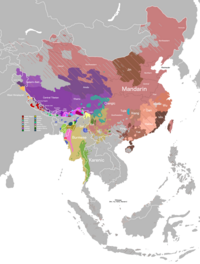Zeme language
| Zeme | |
|---|---|
| Zeliang | |
 "Zeliang" written in Meitei script | |
| Native to | India |
| Region | Assam, Manipur, Nagaland |
| Ethnicity | Zeme Naga |
Native speakers | 110,000 (2011 census)[1] |
| Language codes | |
| ISO 639-3 | nzm |
| Glottolog | zeme1240 |
| ELP | Zeme Naga |
Zeme (also called Empeo, Jeme, Kacha and Zemi[1]) is a Sino-Tibetan language spoken in northeastern India. It is one of the dialects spoken by the Zeme Naga, the other being Mzieme.
Geography and Demography
[edit]Zeme (dialects: Paren, Njauna) is spoken in:[1]
Most Zeme speakers are bi- or multi-lingual in the regional lingua franca of Manipuri and English.[2]
Classification
[edit]Zeme belongs to the Kuki-Chin section of the Kamarupan group of the Baric sub-division of Tibeto-Burman language family. It is closely related to the neighboring languages of Liangmai and Rongmei.[3]
Phonology
[edit]Consonants
[edit]| Labial | Alveolar | Palatal | Velar | Glottal | ||
|---|---|---|---|---|---|---|
| Plosive/ Affricate |
voiceless | p | t | tʃ | k | |
| aspirated | pʰ | tʰ | kʰ | |||
| voiced | b | d | ɡ | |||
| Nasal | m | n | ŋ | |||
| Fricative | voiceless | s | h | |||
| voiced | z | |||||
| Trill | r | |||||
| Approximant | lateral | l | ||||
| central | w | j | ||||
Vowels
[edit]| Front | Central | Back | |
|---|---|---|---|
| Close | i | u | |
| Mid | e | ə | o |
| Open | a |
Zeme also has six diphthongs: /ai, ao, oi, əu, ui, əi/.[6]
Like other Tibeto-Burman languages, Zeme is a tonal language. Most of the words in the language are monosyllabic in nature.[7]
Grammar
[edit]Gender and number are not marked on Zeme verbs. The basic word order is SOV, with an alternate order of OSV, making it a verb-final language.
There are 7 categories of numerals in the language: Cardinals, ordinals, fractionals, multiplicatives, distributives, restrictives, and approximates. The following are cardinal numerals:
| Value | Gloss | Num |
|---|---|---|
| 1 | one | ə-ket |
| 2 | two | ke-na |
| 3 | three | kə-čum |
| 4 | four | mə-dai |
| 5 | five | mə-ŋəiyu |
| 6 | six | sə-rok |
| 7 | seven | sə-na |
| 8 | eight | tə-set |
| 9 | nine | sə-kui |
| 10 | ten | kə-rəiyu |
| 20 | twenty | iŋkai |
| 30 | thirty | him-rəiyu |
| 40 | forty | he-dai |
| 50 | fifty | riŋ-ŋəiyu |
| 60 | sixty | riyak-sərok |
| 70 | seventy | riyak-səna |
| 80 | eighty | riyak-təset |
| 90 | ninety | riyak-səkui |
| 100 | one hundred | hai |
| 1000 | one thousand | čəŋ |
Compound numerals are formed by adding two numerals together, with the bigger numeral, usually a multiple of 10, preceding the smaller one. The decade numerals from 40, 50, 60, 70, 80, and 90 are formed by multiplication of decade by basic numerals by 10. The numeral ‘ten’ in Zeme has four allomorphs: kərəiyu, he, riŋ and riyak.[9]
Notes
[edit]- ^ a b c Zeme at Ethnologue (25th ed., 2022)

- ^ Chanu 2017.
- ^ Chanu 2016, p. 189.
- ^ Chanu 2017, p. 17.
- ^ Chanu 2017, p. 16.
- ^ Chanu 2017, p. 46.
- ^ Chanu 2016, p. 190.
- ^ Chanu 2016, p. 191.
- ^ Chanu 2016, p. 195.
References
[edit]- Chanu, Sapam Sangita (July 2016). "Numerals in Zeme". Language in India. 16 (7): 189–205. ISSN 1930-2940.
- Chanu, Sapam Sangita (2017). A descriptive grammar of Zeme (PhD thesis). Silchar: Assam University. hdl:10603/293382.

